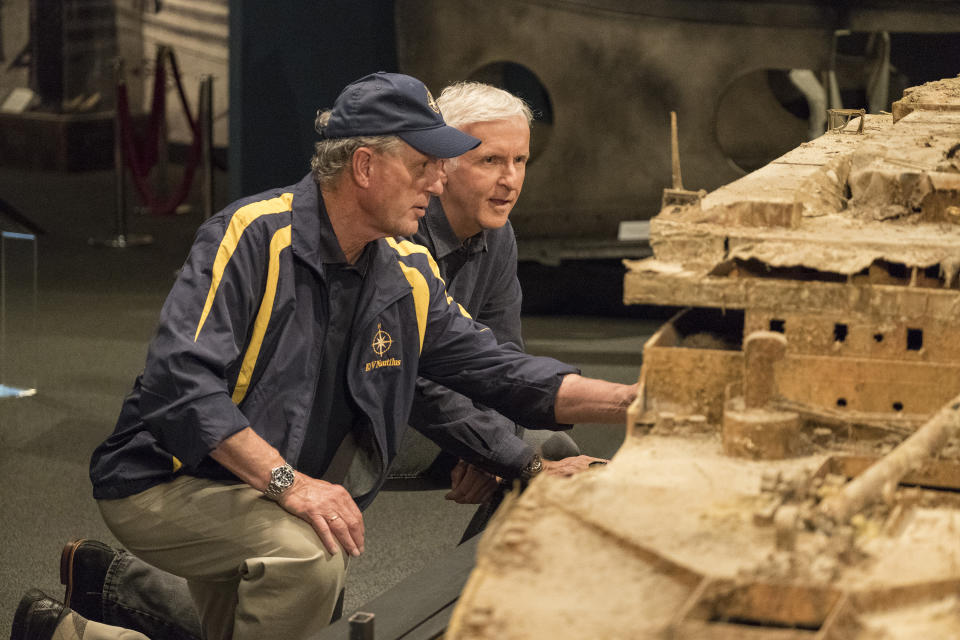James Cameron compares the Titan tragedy to the sinking of the Titanic: 'Warnings went unheeded'
The "Titanic" director and deep sea explorer breaks his silence about the missing submersible.
- Oops!Something went wrong.Please try again later.
Like the rest of the world, filmmaker and deep sea explorer James Cameron has been closely monitoring the story of OceanGate's tourist submersible, Titan, which lost contact with the surface during a dive to the final resting place of the RMS Titanic. It's a site that Cameron knows well, having visited the remains of the ship multiple times in the quarter century since directing his 1997 blockbuster about the doomed passenger liner. Appearing on ABC News in the wake of the Coast Guard's announcement that the five passengers aboard the Titan likely perished following a "catastrophic implosion," Cameron remarked on the "surreal" nature of this latest tragedy.
"I'm struck by the similarity of the Titanic disaster itself," the director noted, referring to the reports that many experts in the deep sea submergence community warned OceanGate about its vessel. "The captain was repeatedly warned about ice ahead of his ship and yet he steamed at full speed into an ice field on a moonless night and many people died as a result.
"For a very similar tragedy where warnings went unheeded to take place at the same exact site... I think is just astonishing," Cameron continued, paying a personal tribute to one of the passengers, 77-year-old French explorer Paul-Henri Nargeolet. "I've known PH for 25 years," the director said. "For him to have died tragically in this way is almost impossible for me to process."
‘Titanic’ director James Cameron on the ‘catastrophic implosion’ of Titan submersible: “I’m struck by the similarity of the Titanic disaster itself, where the captain was repeatedly warned about ice ahead of his ship and yet he steamed at full speed into an ice field." pic.twitter.com/vO8JkCXS5f
— ABC News (@ABC) June 22, 2023
Cameron has been an active member of the deep sea submergence community since the early 2000s. His 2003 documentary, Ghosts of the Abyss, depicted his expedition to the remains of the Titanic and its 2005 follow-up, Aliens of the Deep, showcased the life that exists at the ocean's deeper depths. In 2012, Cameron piloted the Deepsea Challenger into the Challenger Deep — the deepest known part of the seabed.
"I've been down [to the Titanic] many times," Cameron told ABC News, placing his total number of dives to the site at 33. "I actually calculated [that] I've spent more time on the ship than the captain did back in the day."
But Cameron also stressed that he places an enormous value on understanding the science behind his passion. "I designed and built a sub to go to the deepest place in the ocean — three times deeper than Titanic," he said, referring to the Deepsea Challenger. "So I understand the engineering problems associated with building this type of vehicle and all the safety protocols you have to go through."

Cameron cited the implosion that officials believe destroyed the Titan as the kind of "violent event" that's "first and foremost" on the minds of deep sea engineers. "The pressure boundary is what they call the hull of the sub that people go inside of," the director explained. "We spend so much time and energy on that and we use all the computerized tools available today. We worked on our sphere for our vehicle that went to the Challenger Deep for over three years just in the computer before we even made the thing. Then pressure tested it over and over."
That attention to the smallest engineering detail is something that Cameron appeared to suggest wasn't followed by the makers of the Titan. "Many people in the community were very concerned about this sub," he noted. "A number of the top players in the deep submergence engineering community even wrote letters to the company, saying that what they were doing was too experimental to carry passengers and that it needed to be certified." Indeed, in 2018 more than three dozen oceanographers and deep sea explorers penned a letter to OceanGate warning of "catastrophic" consequences due to its "experimental" approach.
According to Cameron, the "take home" message from the Titan tragedy is that deep sea submergence is a "mature art," that is always improving provided safety is closely followed. "The certification protocols that are all over deep submergence vehicles — except this one — that carry passengers... the safety record is the gold standard, absolutely. Not only no fatalities, but also no major incidents requiring all of these assets to converge to a site. That's the nightmare we've all lived with since all of us entered this field of deep exploration. We live with it in the back of our mind."


